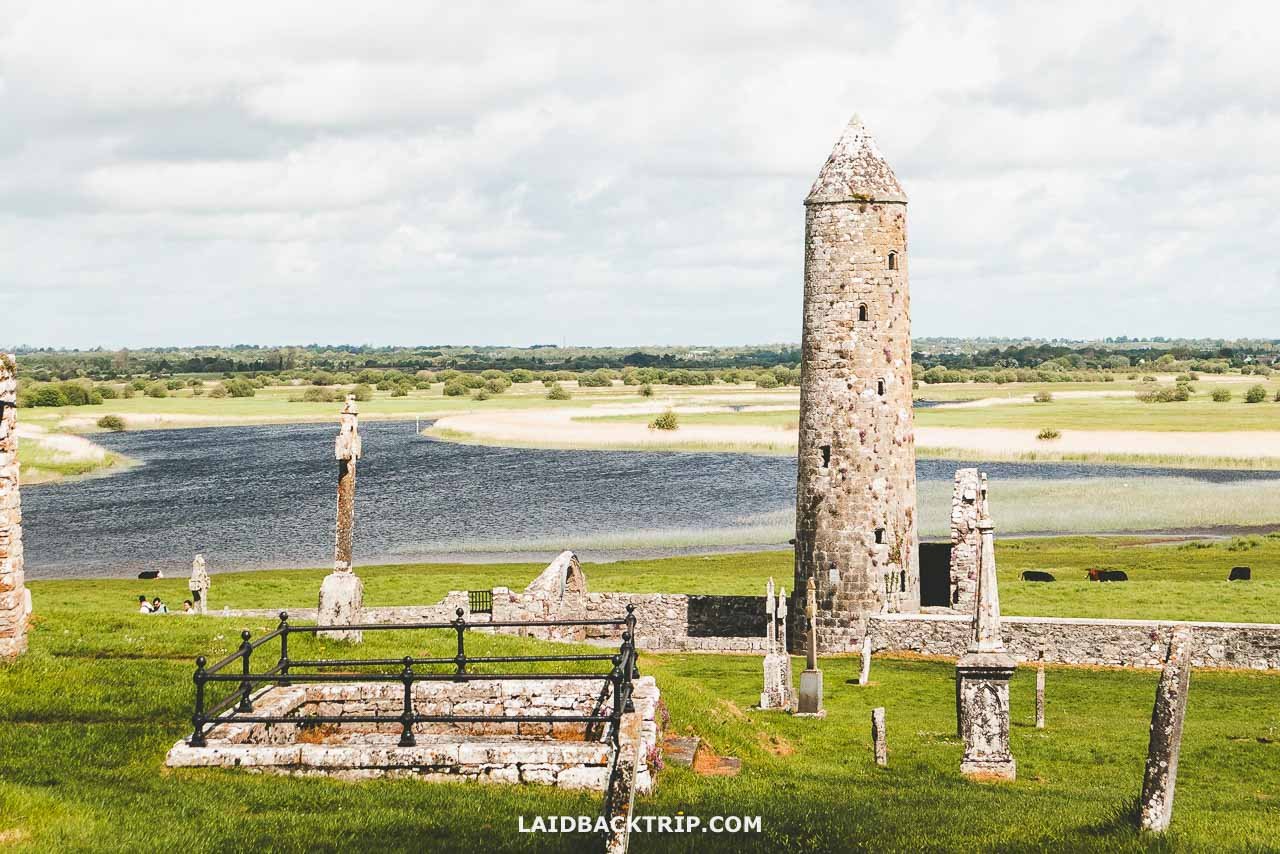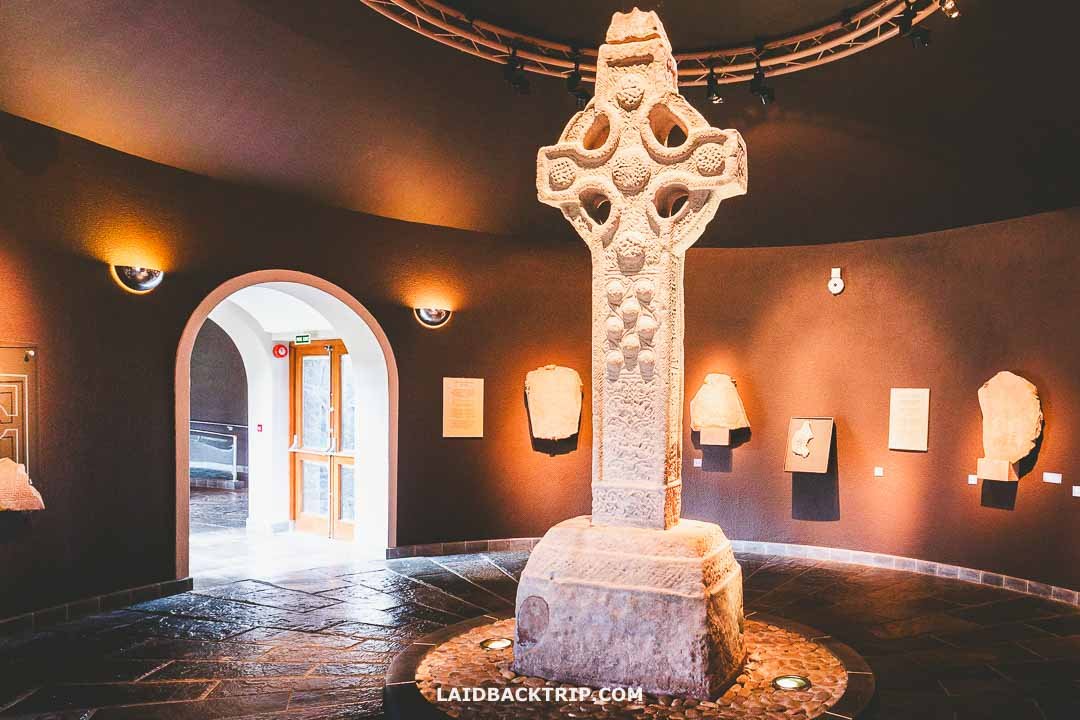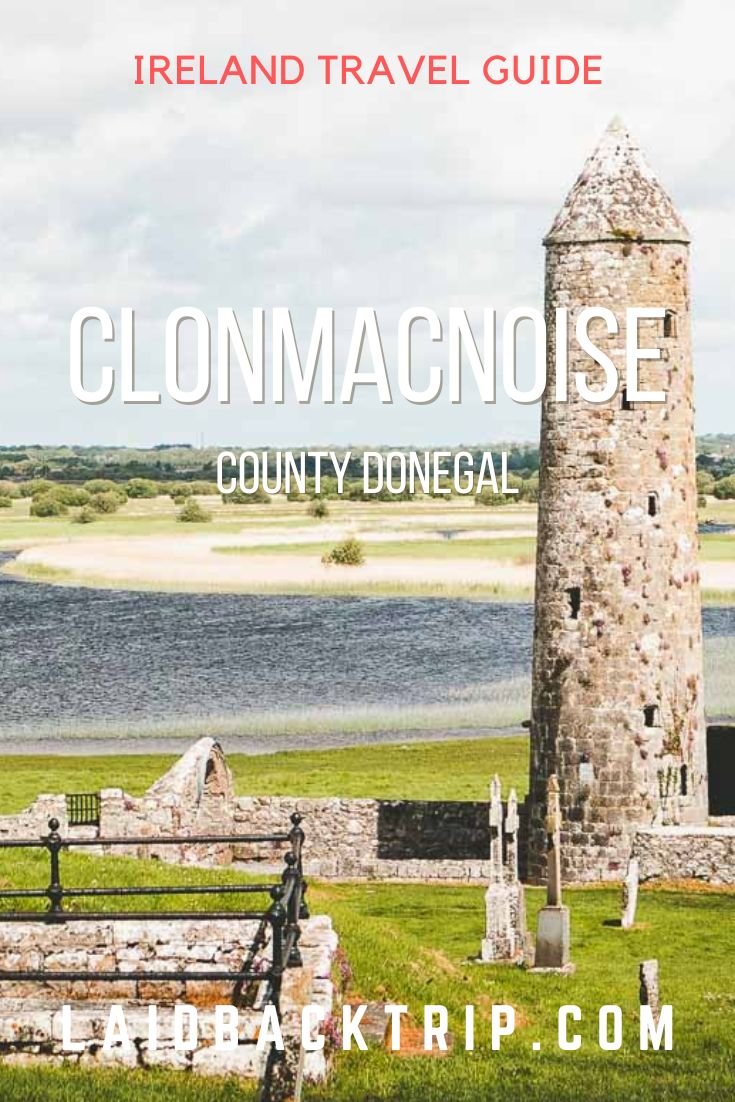How to Visit Clonmacnoise
Read our travel guide on Clonmacnoise in Ireland. Includes best things to do and see, tips on parking, how to get, where to stay, or when to go.
Clonmacnoise is a spectacular monastic site on the banks of the river Shannon.
This ruined monastery is located in County Offaly, south of Athlone town.
Thanks to its central location, it's a great place to visit when driving from Dublin to Galway.
The monastery was founded by Saint Ciaran in the 6th century CE.
Soon after, it became one of the major centers of religion and learning in Ireland.
Today, Clonmacnoise is a National Monument of Ireland and one of the top attractions in Ireland that attracts visitors from all over the world.
Thanks to its strategic location, it's really easy to get there, and this important heritage makes a great addition to every Ireland road trip itinerary.
Visiting Clonmacnoise is very straightforward, though there are a few things you should know about this monastic site before you go.
What to See and Do
There are technically four main attractions to explore at Clonmacnoise.
The monastic ruins, an ancient castle, the River Shannon, and the visitor center with a small museum.
The best part is that it's fun and easy to explore Clonmacnoise on your own.
Alternatively, you can take a tour with one of the knowledgeable guides who will show you some of the most interesting parts of Clonmacnoise and explain everything you want to know about it.
If you have extra time, you can combine both approaches.
Walk around the monastic grounds by yourself and then take a guided tour or vice versa.
History
In 544, Saint Ciaran arrived with seven companions at an area known as Cluain Mhic Nois.
It was a small hill beside the River Shannon in the heart of Ireland.
After he met Diarmait mac Cerbaill, who was later crowned as the High King of Ireland, they built together the first church on this site.
The wooden church was very basic, but that was just a start.
Several small churches and other structures were added to the site throughout the years, and the settlement grew significantly.
Clonmacnoise flourished between the 8th and 12th centuries.
With its central location, the site became more important than ever, and it's estimated that the population grew to about 1500 to 2000 residents by the 11th century.
If you've been to Glendalough Monastic Site, you already know these sites were frequently attacked and looted.
Clonmacnoise was no exception. Normans, Vikings, and Irish raided Clonmacnoise frequently, so stone buildings eventually replaced the wooden structures to withstand increasing attacks.
The rise and growth of Athlone town were, together with frequent attacks and changes in religion, the main reasons why Clonmacnoise began to decline.
Even the religious importance diminished eventually, and Clonmacnoise lost all its former glory.
Finally, English soldiers left the monastic site in ruins after their attack in 1522.
Fast forward a few centuries, and the ruins of Clonmacnoise are a popular tourist attraction managed by OPW.
By the way, Pope John Paul II visited Clonmacnoise during his visit to Ireland in 1979, commemorating its historical importance.
You can see the photos and read more about this event at one of the structures.
As mentioned earlier, today is Clonmacnoise, one of the most popular tourist sites in Ireland.
Visitor Center and Museum
From the parking lot, we headed into a small visitor center, where we purchased the tickets and received some basic information about the site.
Our next steps led us to the small museum, which is home to the original high crosses boasting intricate stonework that are well preserved even after all those years.
The museum is very compact, but it's well laid out and provides good background on Clonmacnoise Monastic Site.
If you're visiting Clonmacnoise for the first time, we highly recommend visiting the museum before venturing out.
It provides information on high crosses, and we found the description of spiritual and secular themes incredibly fascinating.
You can also watch at the interpretive center a short movie to learn even more about Clonmacnoise.
From here, it's only a very short walk to Clonmacnoise Monastic Ruins.
High Crosses
The North Cross, the South Cross, and the Cross of the Scriptures are three spectacular high crosses you can admire at Clonmacnoise.
The high crosses were created in the 8th and 10th centuries and can be found in Ireland and Britain.
The original crosses at Clonmacnoise were removed, and you can see outside convincing replicas in their original locations.
The original crosses can now be seen in the adjacent museum, where you can also find plenty of information about them.
The 4-meter Cross of the Scriptures is the most famous of the bunch.
Each side of this huge piece of sandstone has intricate carvings on all four sides.
The crosses had numerous functions, ranging from protective barriers against evil to pictorial sermons and focal points for meetings and prayers.
The Cross of the Scriptures is located right in front of the entrance of the actual site, while the other two crosses can be found on each side of the Cathedral.
If you pay attention to their appearance while in the museum, it should be easy to find the replicas outside.
Clonmacnoise Monastic Ruins
The ancient stone ruins were tactfully restored with care and consideration over the years, allowing you to easily step back in time.
The whole site is well-preserved and easy to navigate.
We walked around Clonmacnoise on our own, discovering various ruined temples, examining lichen-grown graves, and marveling at high crosses.
Clonmacnoise is very compact and easily explored on foot, and some of its parts reminded us of the Rock of Cashel.
The round towers, high crosses, and the cathedral in the center of the site are easily the most interesting things you can see in Clonmacnoise.
The most notable structures are O'Rourke's Tower, finished in 1124; 12th-century Romanesque Temple Finghin with McCarthy's Tower; and Cathedral (Temple McDermot) with Whispering Arch, the largest church at Clonmacnoise.
A new cemetery and trailhead to Pilgrim's Path can be found at the northeastern edge of the site.
Clonmacnoise also has the largest early Christian grave slab collection in Western Europe.
Due to its former importance, it's no wonder that Clonmacnoise is the burial place of several high kings from East and West, Tara's and Connaught kings.
It's also the final resting place of Rory O'Connor, the last high king of Ireland.
In case you have time, you can also visit Nun's Church, one of the finest examples of Hiberno-Romanesque architecture in Ireland.
This church is about 400 meters from Clonmacnoise and can be reached on foot.
River Shannon
Clonmacnoise was a strategic spot on the River Shannon, an important waterway connecting Ireland's north and south.
If you have been to Limerick, you have already seen a point where the sea meets this major river.
After settling in Ireland during the 10th century CE, Vikings used River Shannon to raid monasteries along the way.
And one of the rich monasteries was Clonmacnoise in today's County Offaly.
From the monastic ruins, the views of the River Shannon are stunning.
Nowadays, you can arrive at Clonmacnoise on a 90-minute Viking Cruise from Athlone.
These boat trips give a sense of what the Vikings saw when they landed and also allow you to see the Shannon Callows.
These protected water meadows between Athlone and Portumna are prone to flooding and are home to many bird species, such as common sandpipers, black-tailed godwits, corncrakes, and lapwings.
Clonmacnoise Castle
When we were ready to leave, there was one more structure waiting to be explored.
The Anglo-Normans, who arrived in County Offaly in the 12th century, built a wooden castle there.
After it burned down, a new, more durable three-story stone version was constructed here.
Unfortunately, it's currently fenced off and closed to the public.
So the only slightly disappointing thing about Clonmacnoise is that the castle that sits atop of lush green hill is not accessible to visitors.
You can already tell from our photos that it's the safety reasons that prevent visitors from getting up close.
The gravity that pulls down the castle's walls toward Earth makes out of this castle one of the most interesting landmarks you can see while touring Ireland.
The castle is set on a green hill, which is also home to cattle, and appears to be leaning toward one of its sides.
Its unusual appearance is incredibly photogenic, and you can recognize the ruins in every picture.
This ruin is simply one of the most beautiful castles in Ireland.
Obviously, the decline of nearby Clonmacnoise Abbey contributed to the castle's downfall.
The Pilgrim's Road to Clonmacnoise
If you're an avid cyclist, you should know that there is a route that follows the ancient Pilgrim's Road.
The route leads along the crest of eskers, raised ridges formed during the last Ice Age about 12.000 years ago.
When the ice melted, these natural formations remained dry and made perfect routes for people moving around this area.
This relatively easy 25-kilometer route connects Ballycumber with Clonmacnoise and can be enjoyed today by bike.
Opening Hours
Clonmacnoise is open all year, apart from Christmas.
It has seasonal opening times, so always make sure to check the official website before you go.
Clonmacnoise is open from 9 AM to 6:30 PM from June to August, which is the peak season in Ireland.
During the spring and fall months (March to May and September to October), Clonmacnoise is open from 10 AM to 6 PM.
Clonmacnoise remains open in winter, and you can visit the site daily from 10 AM to 5 PM.
Depending on the season, the last admission is either 30 or 60 minutes before closing.
Entrance Fee
The entry fee to Clonmacnoise is €8 per adult, and it's recommended to book your tickets in advance of your visit.
If you're traveling on a budget in Ireland, it's a great alternative to expensive places such as Blarney Castle or Bunratty Castle.
How Much Time Do I Need
We spent about two hours at Clonmacnoise, which we believe is about an average amount of time most visitors will need to get the most out of this place.
If you're pressed for time, an hour should be fine for Clonmacnoise, including the museum.
The site is fairly compact, and we know from our personal experience that not every site requires several hours of your time.
When to Go
You can explore Clonmacnoise at any time of the year, and there really isn't any best time to visit.
Therefore, the best approach is to figure out when is the best time to visit Ireland first.
Summer is the peak season on Emerald Isle for an obvious reason.
The weather is at its best, and days are long, warm, and sunny. However, many sites are crowded, and hotels get expensive.
One of the best reasons to visit Ireland during spring or fall is that many places are less crowded than they are in the summer, and Clonmacnoise is no exception.
You can also visit Clonmacnoise in winter.
Just remember that the weather can be quite miserable during this period, especially along the coastline.
Due to its popularity, early morning or late afternoon is the best time of the day to enjoy Clonmacnoise without crowds.
By the way, Clonmacnoise is one of those places that are also great to visit, even on a rainy day.
In fact, visiting historical sites in Ireland on a foggy day can be a magical experience.
What to Pack
Even though the Clonmacnoise site is small and compact, make sure your shoes are comfortable and supportive.
Regardless of the season, it's not uncommon for it to rain in Clonmacnoise.
Therefore, we suggest keeping some rain gear in your daypack.
Honestly, a quality rain jacket is the most important item on every Ireland packing list.
Outside the summer season, you will most likely need to wear an extra layer or two to stay nice and warm.
The site is exposed, so protect yourself from the sun and stay hydrated.
How to Get There
Clonmacnoise is located halfway between Dublin and Galway, just off the M6.
There are several ways to reach this monastic site, depending on where you are coming from.
By far, the easiest way to get to Clonmacnoise is by car, at least if you want to rent a car in Ireland.
Car
Clonmacnoise sits on R444, about 25 kilometers south of Athlone.
When driving, you should reach Clonmacnoise in less than two hours from Dublin via M4/M6 route.
Galway is just 80 kilometers west of Clonmacnoise, and the journey via M6 takes about an hour.
You can reach Clonmacnoise from Limerick in about 90 minutes.
When departing from Cork, you will spend about three hours on the road via M8/N62.
The journey from Kilkenny to Clonmacnoise takes just under two hours.
Travel Resources
When renting a car, we use Rentalcars.com.
Parking
There is free parking at Clonmacnoise.
The parking lot is conveniently located right next to the visitor center.
However, it's not exactly large, given the popularity of Clonmacnoise, and it looks like it gets full quickly during the peak season.
The parking area is closed outside of business hours.
Public Transport
There is no direct bus or train to Clonmacnoise.
Athlone, the nearest town to Clonmacnoise, is well-connected with two major Irish cities, Dublin and Limerick.
You can either get there by bus or even train if that's your preferred mode of transport.
Athlone is about a 30-minute drive from Clonmacnoise, and you can take a taxi or boat to get there.
Boat
In case you want to make your visit a bit more special, consider taking a boat tour that will take you from Athlone to Clonmacnoise.
The River Shannon Viking Boat Tours are a great way to experience the midlands region of Ireland and are often ranked as one of the best things to do in Westmeath (and Offaly).
Where to Stay
When it comes to accommodation near Clonmacnoise, your safest bet is the small town of Athlone.
The town sits on M6, a busy highway that connects Dublin with Galway, making it a great place to stay overnight. You can find several hotels, bed and breakfasts, or home apartments here.
Obviously, you can also stay in Dublin or Galway, depending on your preferences and itinerary.
If you want to enjoy the peace and quiet of the countryside and traditional Irish hospitality, there are many bed and breakfasts dotting the countryside.
Here are the best hotels near Clonmacnoise.
Budget | Shamrock Lodge Hotel - This budget hotel is located within a 10-minute walk from the center and has cozy and clean rooms, welcoming staff, good food, and free parking.
Mid-range | Athlone Springs Hotel - Nestled in Athlone's residential suburb, this hotel boasts spacious rooms, a modern design, a 20-meter swimming pool, a sauna, and more. Free private parking is available at the hotel. Great value for money.
Luxury | Sheraton Athlone Hotel - This 4-star hotel is conveniently located in Athlone's lively center. It has spacious and elegant rooms, a great restaurant, a 20-meter pool, a luxury spa, and free parking. This property is among the best hotels in Athlone.
Staying Safe
Clonmacnoise is a safe place to visit. It's a small site, so you just need to use your common sense, and you should be fine.
Really, this is Ireland's top tourist attraction, and we felt very safe there.
If driving in Ireland, don't leave your valuables in your car.
Obviously, you should follow this general travel tip whether you're at Clonmacnoise, Ring of Kerry, or Cliffs of Moher.
Here you will find more tips on staying safe in Ireland.
Travel Insurance
We never leave home without travel insurance that was designed to cover our expenses if something goes wrong during the trip.
Travel insurance protects against theft, flight delays, injury, illness, cancellations, and much more.
World Nomads provides travel insurance for travelers to cover their trip essentials, including sports and adventure activities.
SafetyWing is affordable travel insurance for backpackers, long-term travelers, and digital nomads.
Travel smarter and safer!
Is Clonmacnoise Worth Visiting?
Clonmacnoise is one of the most important historic sites in Ireland, and we believe it's definitely worth seeing.
There is plenty to see and do at the site itself for all types of travelers, but it's an especially great place to visit if you're a history lover.
After touring the Wild Atlantic Way, Clonmacnoise was the main reason why we also headed inland.
Simply put, Clonmacnoise was one of our favorite stops on the whole Ireland road trip.
The combination of idyllic landscape, ancient high crosses, 1500 years old structures, and views of the Shannon River makes a captivating experience.
Plus, it offers a great insight into what life must have been like there when the monastic settlement was buzzing with energy and monks.
Travel Resources
Here you can find links to all the travel resources we use and which you might find helpful when planning your next holiday.
Accommodation: When looking for accommodation, we usually search hotels via Booking.com or Hostelworld.
Tours: Although we love to travel independently, some places are better to visit with a guided tour.
We prefer GetYourGuide for its easy-to-use interface and solid reputation. Another great alternative is Viator.
Rental Cars: When going on a road trip, we always use Rentalcars.com, a reliable site for booking a rental car in advance.
Flight Tickets: When looking for flight tickets, you can search Skyscanner to find the best price.
Travel Insurance: World Nomads and SafetyWing cover against risks of travel.













